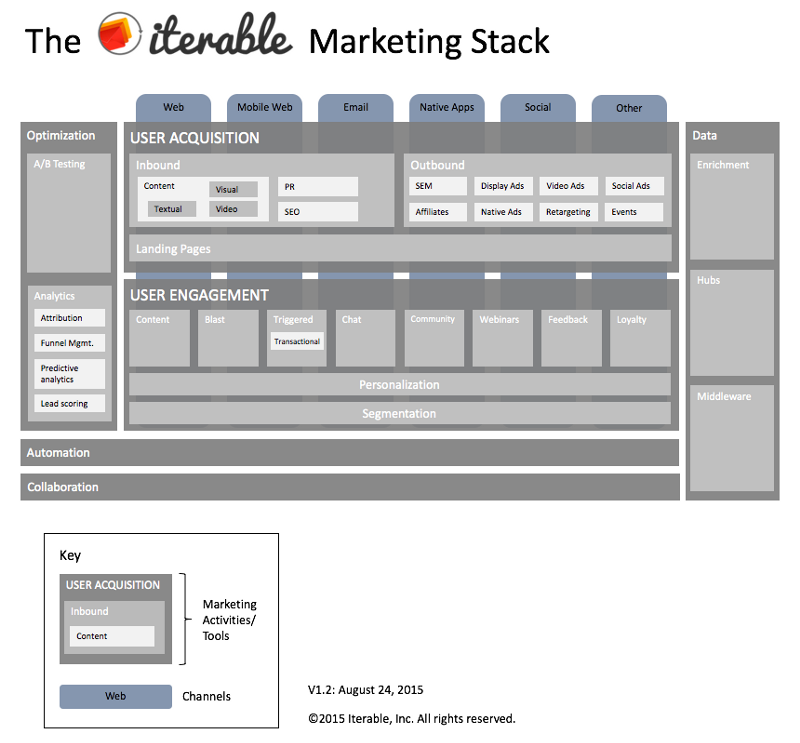This is the third post in our Marketing Stack series. In the first post we introduced our marketing stack and in the second post we went into more detail on user acquisition and user engagement.
In this post we are going to do a brief overview of the remaining layers and then start laying the foundation for our growth marketing framework.


The four remaining layers of the stack (optimization, data, automation and collaboration) are all about improving and/or simplifying user acquisition and engagement.
Optimization
Within the Optimization function there are two key subcategories: Analytics and A/B testing.
The goal of Analytics is to help the marketer understand what is happening, and it can be applied across all layers of the stack.


Many individual tools provide analytics to better understand their specific functions, but there are also general purpose analytics platforms that can take data from many different sources and give the marketer broader insights into the performance of their activities. A more recent development are analytics platforms that use data (and often machine learning) in order to predict what users may do in the near future (i.e., predictive analytics). Analytics has become a very important part of the marketing stack — after all, you can rarely improve what you don’t measure.
A/B testing relies on analytics and its function is to enable the optimization of a specific metric by making changes to a variable, running the variants side-by-side, comparing the results and declaring a “winner”. The variable can be anything, from the color of a website button to the time of day an email is sent. The metric being optimized is usually some form of conversion, like a registration, a purchase or some other user activity of value. A/B testing, of course, is just a catchall term for the category as there can be increasing levels of complexity in how testing is done, leading to things like A/B/x testing and multivariate testing.
Data
The explosion in the sophistication of marketing has directly led to two intertwined data trends:
- Marketers want as much data as possible on their users in order to improve targeting, conversions, etc. This has led to the demand for data enrichment services — bringing in data from third parties that can help marketers do their jobs better.
- As marketers take up more activities, they’ve had to collect increasing amounts of data and share it amongst more systems and services. This is where middleware and data hubs come in — their goal is to make data sharing simpler.


It’s worth briefly explaining the difference between middleware and data hubs.
Middleware is just a “glue layer” between different systems and services. A middleware provider doesn’t store your data, it just passes it from one system to another with some translation or transformation along the way. Middleware has been around for a long time, dating back to (at least) the client-server systems that emerged in the 90s. However, there is a new generation of cloud-based middleware that serves many of the same functions with a much lighter footprint.
Data hubs are a newer phenomenon and are fundamentally different from middleware in that they actually do store your data. This is becoming more useful as marketers use an increasing number of cloud services — a data hub can serve as a central repository that gives access to, and receives data from, authorized services.
Both middleware and data hubs eliminate a lot of the complexity in data sharing, especially when they have “pre-made” integrations with 3rd party services.
Automation
This layer is straightforward: it’s all about automating activities that the marketer would otherwise have to do themselves, or that they would be unable to do because of their complexity or workload.
“Marketing automation” is now a large software category in and of itself (and one where Iterable plays). While many uses of marketing automation are fairly trivial (e.g., send an email as soon as someone registers), there is potential for automation to play a very important role throughout the stack, freeing the marketer from doing unnecessary work but also enabling powerful new ways of acquiring and engaging users.
Collaboration
One could argue this layer of the stack is not marketing-specific, but rather a layer that applies equally to all types of work, and for this reason we will probably spend relatively little time analyzing it.
However, we felt it was worth calling out because new collaboration platforms have emerged that are serving as “portals” of sorts to the systems and data in the stack. If this trend continues, these services may become integral to how a marketer does their job and may in fact start specializing and adding marketing-specific functionality. Therefore we think it’s worth keeping an eye on this layer as it evolves.
This concludes our functional overview of the Iterable Marketing Stack. But this leads us to the more interesting parts of our framework and analysis. As mentioned in the first post, our ultimate goal is to explore:
- How the different tools fit together.
- What areas can best drive growth (and how).
- How a company’s stack evolves as they grow in size and sophistication.
We’ve covered a good portion of the first bullet point and we’ll now embark on the second and third points.
Growth marketing has come to the fore in the last few years, especially at startups in Silicon Valley. It’s easy to think there is something special about what these terms mean, but they can be summarized in three steps:
- Identify what “growth” means in your business and at your stage of development. Be specific.
- Isolate the individual levers that can drive this growth (note: this can be several levels deep).
- Systematically measure, test and optimize each lever, with the growth metric(s) as the optimization goal.
From a process perspective, there are four aspects of growth marketing that are frequently mentioned as key to the approach: doing things leanly (i.e., in a low-cost way), iterating quickly, utilizing technology in smart and scalable ways, and marketing across all the communication channels.
In the next few posts in this series we’ll look at growth marketing in the context of the marketing stack and what it can mean for growth marketers today.
































